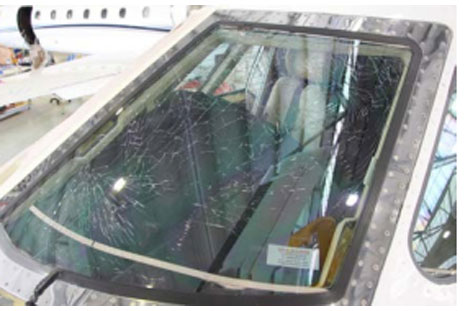
| • | Secondary Cockpit Barrier Legislation Introduced in U.S. |
| • | Operations: Responding to Cockpit Window Cracks |
| • | Keep the Safety Data Flowing Through C-FOQA |
| • | FAA Warns Pilots About Passengers’ Oxygen Bottles |
| • | Afghanistan 747 Accident Investigators Study Video |
.gif)
Safety Spotlights...
Many Australian R44s Fail To Comply with AD
Despite a number of recent fatal accidents involving post-crash fires blamed on the Robinson R44’s vulnerable aluminum fuel tanks, and despite the Australian Civil Aviation Safety Authority’s (CASA) publishing an airworthiness directive demanding replacement with improved flexible bladder versions, many operators have failed to comply. “Up to 100 R44s in Australia are still at an elevated risk of post-impact fire after an accident because their fuel tanks will not have been retrofitted with the bladder tanks by the April 30 [deadline],” said the Australian Transport Safety Bureau’s chief commissioner, Martin Dolan, as the compliance date approached.
Fort Lauderdale Runway Changes of Note
Local changes in magnetic variation demanded that Runway 9L/27R at Hollywood/Fort Lauderdale Airport (FLL) be renumbered 10L/28R. On May 3, the airport also began a number of other construction projects that will continue through September next year, including the permanent decommissioning of the airport’s crosswind Runway 13/31 as well as significant new taxiway construction in advance of the opening of a new Runway 10R/28L. For the next 17 months, FLL’s only operational runway will be 10L/28R.
Mexican King Air Crash Kills Six
Six people aboard a Mexican government-owned Beech King Air 300 were killed April 30 when the turboprop crashed five minutes after takeoff from Aeropuerto Internacional de Zacatecas Airport (MMZC) in central Mexico. A post-crash fire destroyed the aircraft.
Indian Pilots Allow Flight Attendants To Fly Airbus
Two Air India pilots and a pair of flight attendants have been suspended from duty pending an investigation into an April 13 incident in which both pilots left the flight deck of the Airbus A321 at the same time for 40 minutes of rest in the cabin. The pilots left two flight attendants in the cockpit to monitor the aircraft. The pilots returned to the cockpit only after one of the flight attendants mistakenly turned off the autopilot.
Qatar Courts ICAO To Move from Montreal to Doha
Canadian foreign affairs minister John Baird said he was caught off guard by a recent proposal by the Qatar government inviting the International Civil Aviation Organization (ICAO) to move its headquarters from Montreal to Doha. He said the wealthy Middle East nation is offering a significant amount of money to convince the United Nations’ aviation regulating body to consider the move. No one mentioned the proposal to Baird on a recent visit to Doha before the announcement. ICAO has been based in Montreal since 1946.
AINsafety welcomes your feedback
News tips may be sent anonymously but feedback must include your name, e-mail address and telephone number. We will withhold names on request, but we must have your contact information for verification purposes. We reserve the right to edit correspondence for length, clarity and grammar. Send feedback or news tips to Robert P. Mark.

U.S. Congressman Mike Fitzpatrick has proposed new legislation [H.R. 1775] to require secondary cockpit safety barriers on Part 121 airliners. The metal barrier would be lowered between the first row of seats and the existing hardened cockpit door whenever a pilot leaves the flight deck. The extra-barrier idea evolved from a study conducted by the Radio Technical Commission for Aeronautics (RTCA) at the request of the FAA, the Air Line Pilots Association and other industry stakeholders to provide more specific guidance on securing the flight deck. Currently, many airlines require flight attendants to push a service cart into the aisle to block any attempt to enter the cockpit when the door opens in flight. The secondary barrier looks much like a six-foot-tall oven rack-like door that flight attendants could swing into the aisle to block access. Fitzpatrick’s bipartisan-sponsored legislation [backed by four Democrats and four Republicans, and introduced on April 29] is called the Saracini Aviation Safety Act in honor of Victor Saracini, who was captain of United Flight 175, the Boeing 767 flown into the south tower of the World Trade Center in the 9/11 terrorist attacks. Saracini’s widow, Ellen, became interested in the barrier topic when she learned that United Airlines is attempting to remove newly installed secondary barriers from all its Boeing 787s. Without answering the question of why the barriers were being removed, a United spokesman told AIN that the proposed new rule will “affect all airlines.” An Airlines for America spokesman told AIN the association believes “the decision about whether to install secondary barriers should be left to individual carriers.”

Operations: Responding to Cockpit Window Cracks
An investigation by the Australian Transport Safety Bureau concluded that good planning and quick crew reactions were responsible for the lack of
 injuries and significant damage after failure of the windshield of an Australian-registered Citation X on January 15. The aircraft had just leveled at FL450 after departing Samoa’s Faleolo International Airport (NSFA) for Sydney Airport (YSSY) when the crew received a “left windshield heat inoperable” warning that required the aircraft to leave icing conditions. The pilot flying reported the left windshield was still warm to the touch at this point. Two minutes after that check, the windshield’s outer ply shattered with a loud bang, at which point the crew turned both windshield heating switches to “off.” The flight crew completed the emergency depressurization checklist, donned their oxygen masks, deployed the passenger oxygen masks and started a descent as they turned toward Nadi International Airport in Fiji. The pilot flying reported that the windshield cracking did not progress further during the descent, nor did the cabin depressurize. At 14,000 feet the crew and passengers removed their masks and the flight landed normally at Nadi, with no injuries to anyone on board.
injuries and significant damage after failure of the windshield of an Australian-registered Citation X on January 15. The aircraft had just leveled at FL450 after departing Samoa’s Faleolo International Airport (NSFA) for Sydney Airport (YSSY) when the crew received a “left windshield heat inoperable” warning that required the aircraft to leave icing conditions. The pilot flying reported the left windshield was still warm to the touch at this point. Two minutes after that check, the windshield’s outer ply shattered with a loud bang, at which point the crew turned both windshield heating switches to “off.” The flight crew completed the emergency depressurization checklist, donned their oxygen masks, deployed the passenger oxygen masks and started a descent as they turned toward Nadi International Airport in Fiji. The pilot flying reported that the windshield cracking did not progress further during the descent, nor did the cabin depressurize. At 14,000 feet the crew and passengers removed their masks and the flight landed normally at Nadi, with no injuries to anyone on board.
Keep the Safety Data Flowing Through C-FOQA
Steve Charbonneau, a pilot and chairman of the NBAA’s corporate flight operational quality assurance (C-FOQA) program, is leading a team to
 develop best practice standards for data gathering from the digital flight data recorders (DFDR) that are now standard on most new large business jets. “The goal is to analyze and share data to give operators both the qualitative and quantitative boost they need to develop their organization into world-class operations,” he said. While a C-FOQA sounds like a no-brainer to proponents of such safety mechanisms, some flight department employees aren’t so sure. “There can be apprehension [the pilots] are being watched by the ‘boss’ and will be punished or reprimanded for any deviation,” said Charbonneau. “Deploying a C-FOQA can actually motivate a cultural shift toward an environment of trust and understanding.” He refuted the suggestion that C-FOQA is a waste of time, arguing that even the most competent operators have something to learn from the process. “Operators who fear discovery [of their data by the wrong people] are often the ones who have the most to gain from C-FOQA,” he concluded. “It allows them to face their problems head on [and fix them]. If no problem exists, there is newfound confidence and the fear of discovery dissolves.”
develop best practice standards for data gathering from the digital flight data recorders (DFDR) that are now standard on most new large business jets. “The goal is to analyze and share data to give operators both the qualitative and quantitative boost they need to develop their organization into world-class operations,” he said. While a C-FOQA sounds like a no-brainer to proponents of such safety mechanisms, some flight department employees aren’t so sure. “There can be apprehension [the pilots] are being watched by the ‘boss’ and will be punished or reprimanded for any deviation,” said Charbonneau. “Deploying a C-FOQA can actually motivate a cultural shift toward an environment of trust and understanding.” He refuted the suggestion that C-FOQA is a waste of time, arguing that even the most competent operators have something to learn from the process. “Operators who fear discovery [of their data by the wrong people] are often the ones who have the most to gain from C-FOQA,” he concluded. “It allows them to face their problems head on [and fix them]. If no problem exists, there is newfound confidence and the fear of discovery dissolves.”
FAA Warns Pilots About Passengers’ Oxygen Bottles
The FAA is cautioning cabin and cockpit crewmembers to guard against passengers attempting to bring personal oxygen bottles on board an aircraft. Contained O2 is considered a hazardous material both as a non-flammable gas and an oxidizer. Part 121 and 135 regulations do allow air carriers to provide passengers with onboard compressed oxygen for personal use, provided they follow guidelines in their FAA-approved aircraft maintenance manual. However, these carriers are not allowed to permit passengers to bring their own oxygen tanks aboard. Some air ambulance flights can be permitted to carry passenger oxygen bottles aboard for use at the destination, provided the operator follows guidelines in CFR 175.501 (e).
Afghanistan 747 Accident Investigators Study Video
The investigation into the April 29 crash of a National Air Cargo Boeing 747-400 at Bagram Air Base in Afghanistan is being aided by a video caught by a witness in a nearby vehicle that shows the aircraft in a steep climb shortly after takeoff, followed by wing rolling and an eventual stall before the aircraft struck the ground. Seven people aboard the Boeing died in the crash. Early speculation about accident causes is focused on whether one or more of the heavy vehicles aboard might have broken free during rotation and rolled toward the tail, moving the CG aft to the point that the aircraft was uncontrollable.
AINsafety is a publication of The Convention News Co., Inc., 214 Franklin Avenue, Midland Park, NJ 07432. Copyright 2013. All rights reserved. Reproduction in whole or in part without permission from The Convention News Co., Inc., is strictly prohibited. The Convention News Co., Inc., publishes Aviation International News, AINalerts, AIN Defense Perspective, AIN Air Transport Perspective, AINmxReports, AINsafety, Business Jet Traveler, BJTwaypoints, ABACE Convention News, Dubai Airshow News, EBACE Convention News, Farnborough Airshow News, HAI Convention News, MEBA Convention News, NBAA Convention News, Paris Airshow News, Singapore Airshow News, iPhone Apps: AINonline • BJTonline